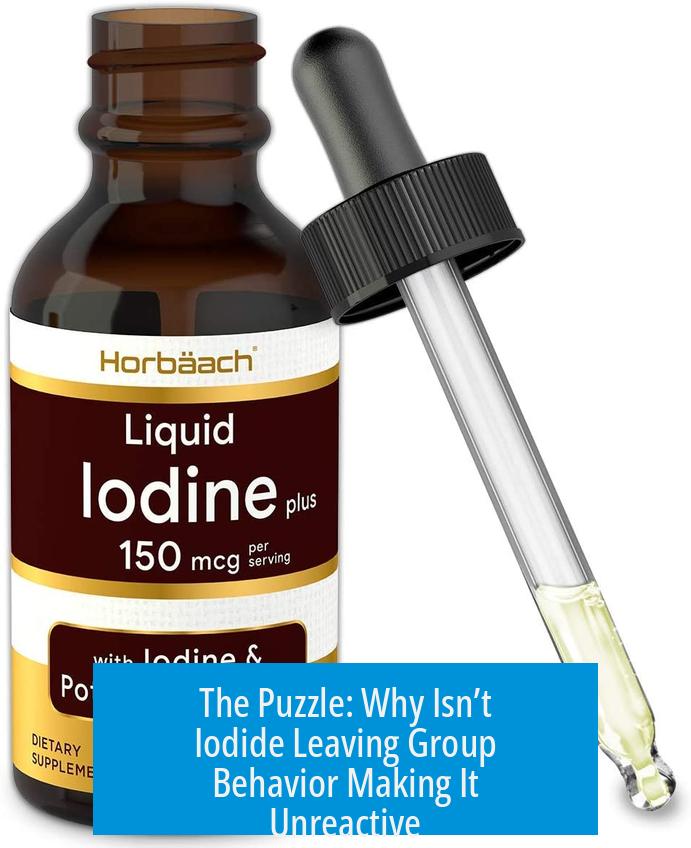Is Iodine a Better Leaving Group, Shouldn’t It Be Unreactive?

Iodine, or more accurately the iodide ion (I−), is indeed a better leaving group compared to other halides like chloride (Cl−) or bromide (Br−), but this does not make compounds containing it unreactive. In fact, iodide’s excellent leaving group ability often makes compounds more reactive in nucleophilic substitution reactions. The confusion arises because iodide also acts as a strong nucleophile, which creates a dynamic equilibrium in halide exchange reactions. This article clarifies why iodine’s effectiveness as a leaving group does not translate into unreactivity and explains how reaction conditions shape the outcome.
Why Is Iodide Considered a Better Leaving Group?

Leaving group quality depends on stability after departure from the substrate. Iodide is large and polarizable, dispersing its negative charge effectively once it leaves. This results in a more stable, less reactive leaving group compared to chloride or bromide.
- Greater polarizability reduces energy required to cleave the bond.
- Iodide ion is weakly basic, stabilizing the negative charge post departure.
- Its bond to carbon tends to be weaker due to size mismatch, facilitating easier departure.
Thus, iodide ions leave more easily during substitution, generally accelerating these reactions.
The Puzzle: Why Isn’t Iodide Leaving Group Behavior Making It Unreactive?

Iodide’s superior leaving group ability can seem contradictory. If it leaves easily, why don’t reactions stall or become unreactive after iodide departs?
- In halide exchange reactions (e.g., Finkelstein reaction), iodide not only leaves but also attacks as a nucleophile.
- This duality means iodide can substitute other halides and also be replaced, setting up an equilibrium.
- Reactions are reversible and depend on relative nucleophilicity and leaving group abilities of halides involved.
Understanding the Finkelstein Reaction: A Practical Example

The Finkelstein reaction involves exchanging halides, generally transforming alkyl chlorides or bromides into alkyl iodides using sodium iodide (NaI).
Here, iodide is both:
- The nucleophile attacking alkyl chloride.
- The leaving group when displacing chloride later.
Essentially, iodide replaces chloride through an SN2 mechanism where the nucleophile attacks the electrophilic carbon, and the leaving group departs.
Role of Nucleophilicity

Iodide is a better nucleophile than chloride. Larger atoms with more diffuse electron clouds tend to donate electron pair density more effectively.
- Iodide’s polarizability allows it to better stabilize the transition state.
- This improves reaction rates when it attacks alkyl groups.
Reversibility and Equilibria
Because both iodide and chloride can act as nucleophiles and leaving groups, halide exchange is reversible. This can appear like the reaction becomes sluggish or unreactive.
- If chloride competes effectively as a nucleophile, equilibrium may favor the starting materials.
- Without further driving forces, the system remains in dynamic balance.
How Reaction Conditions Influence Reactivity
The key to understanding iodide reactivity lies in the reaction environment. Several factors dictate how these equilibria behave:
1. Concentration of Reactants
- Excess NaI is often used to push the reaction toward the product side by Le Chatelier’s principle.
- Using more iodide shifts equilibrium to favor substitution of chloride with iodide.
For example, the typical practice involves adding 5 or more equivalents of NaI relative to alkyl chloride.
2. Solvent Effects
The solvent influences ion solvation and salt solubility, critical in shifting equilibrium.
- Methanol is polar and stabilizes chloride ions well, potentially slowing displacement by iodide.
- Acetone is less polar; sodium chloride is poorly soluble and precipitates out, removing it from solution.
- This precipitation shifts equilibrium to favor alkyl iodide formation.
Choosing a suitable solvent can thus enhance the yield and rate of halide exchange.
3. Solubility and Precipitation
Sodium halide salts formed as byproducts can modulate reaction direction:
| Salt | Solubility in Acetone | Effect on Equilibrium |
|---|---|---|
| NaCl | Low (precipitates) | Precipitation drives equilibrium toward alkyl iodide |
| NaI | High (stays dissolved) | Provides continuous supply of nucleophile iodide |
This contrasts with methanol media, where salt removal does not happen, and equilibrium remains less favorable.
Summary Table: Factors Affecting Iodide’s Reactivity as a Leaving Group
| Factor | Effect on Reactivity | Explanation |
|---|---|---|
| Leaving Group Ability | Increases reactivity | Iodide stabilizes charge well, leaves easily. |
| Nucleophilicity | Allows reversible reactions | Iodide also attacks alkyl centers, competing with chloride. |
| Concentration | Favors product formation | Higher [I−] pushes equilibrium to alkyl iodide. |
| Solvent Polarity | Modifies ion stability | Polar solvents stabilize chloride; less polar favor iodide substitution. |
| Salt Precipitation | Drives reaction forward | Precipitation of NaCl removes product from solution. |
Why This Matters for Organic Chemistry
Understanding iodide’s role clarifies many misconceptions in nucleophilic substitution reactions. Its dual behavior as strong nucleophile and excellent leaving group gives rise to equilibria that can be manipulated by choices in solvent, concentration, or reaction design.
These principles are crucial in synthetic strategies involving alkyl halides and halogen exchange, allowing chemists to control reaction pathways and yields effectively.
Key Takeaways
- Iodide is a better leaving group, which speeds up substitution reactions.
- Iodide’s nucleophilicity creates reversible halide exchange equilibria, not inertness.
- Excess iodide ions push equilibrium toward product formation via Le Chatelier’s principle.
- Solvent choice, especially acetone vs. methanol, influences salt solubility and reaction equilibrium.
- Precipitation of byproduct salts like NaCl drives the reaction forward by removing product from solution.
If Iodine Is a Better Leaving Group, Shouldn’t This Be Unreactive?
At first glance, you might think that since iodine is a great leaving group, the reaction would just stall, right? But in the bustling world of organic chemistry, that’s a big misconception. Let’s break down why iodine’s prowess as a leaving group doesn’t translate to unreactivity. Instead, it sparks fascinating reaction dynamics.
Confused about how iodide plays double duty—as both a stellar leaving group and a knight-in-shining-armor nucleophile? You’re not alone. This paradox often trips up students first diving into SN1 and SN2 reactions, especially in mechanisms like the Finkelstein exchange.
The Iodide Paradox: Leaving Group Meets Nucleophile
Think of iodide (I−) as the overachiever of halides. It’s a top-tier leaving group because the carbon–iodine bond is weak, making it easy for iodine to hop off. But—and here’s where the twist lies—it’s also a formidable nucleophile, better even than chloride (Cl−).
Why is iodide a better nucleophile? Simple. The bigger the atom, the more diffuse its electron cloud and the less tightly its charge is held. This makes iodide’s negative charge spread out and shielded at the molecule’s surface, which lets it attack electrophiles more easily than the smaller chloride ion.
So iodide isn’t just waving goodbye to the molecule—it’s also one of the best party crashers, ready to jump back in. This dual nature means the reaction is reversible, teetering between reactants and products.
Reaction Conditions: The Real MVP
Here’s the not-so-secret secret: reaction conditions play the starring role in this story. Le Chatelier’s Principle comes to the rescue by showing how we can coax the reaction forward.
Imagine you’re doing a Finkelstein reaction to swap a chloride for iodide on a methyl group. Adding a surplus of sodium iodide (NaI)—sometimes *five times* as much as the alkyl chloride—pushes the equilibrium hard towards the iodide product.
It’s like having an army of iodide ions ready to take the stage, crowding out chloride ions. Even though iodide is a terrific leaving group (which might suggest a backward reaction), the excess forces the forward reaction to dominate.
What About Solvent Effects? The Plot Thickens
Solvents do more than just dissolve substances; they’re the unsung directors behind the scenes. The choice of solvent dramatically affects the stability of both nucleophiles and leaving groups.
In a polar solvent like methanol, chloride ions feel pretty comfortable—they are more stable, which can slow down the substitution. Meanwhile, iodide ions, with their larger size and diffuse charge, don’t get the same cozy ride.
On the flip side, a less polar solvent such as acetone can shake things up. Here’s why: sodium chloride (NaCl), a byproduct when iodide kicks out chloride, is barely soluble in acetone and quickly precipitates out.
This precipitation removes chloride ions from the solution, pushing the reaction forward—engineered equilibrium, if you will. Without acetone, the reaction hovers near equilibrium, with both sides grappling for dominance.
Reactivity and Equilibrium: It Always Depends
Yes, chemistry loves its “it depends” moments. Whether iodide acts as a leaving group or as a nucleophile depends heavily on various factors:
- Concentration: More iodide pushes the reaction toward product. Less iodide? The reverse might happen, or the reaction barely moves.
- Solvent: Polar vs. nonpolar solvents shift the balance of ion stability and solubility.
- Conversion metrics: Sometimes reactions only reach 30% completion, which drastically affects perceived reactivity.
So, this isn’t a simple “better leaving group means no reaction” scenario. Instead, the iodide jump rope game continues: it leaves one molecule only to attack another.
Bringing It All Together: Why Iodide’s Status as a Great Leaving Group Doesn’t Freeze the Reaction
In simpler terms: iodide’s excellence as a leaving group doesn’t make the reaction unreactive because it is *also* an excellent nucleophile. This dual nature creates a dynamic, reversible process rather than a one-way street.
We see this most clearly in the Finkelstein reaction, where the equilibrium can be pushed toward formation of the alkyl iodide by adjusting concentrations and choosing the right solvent. Acetone is the secret weapon that precipitates out NaCl and nudges the reaction to completion.
The savvy organic chemist can harness these principles, designing reaction conditions that tip the balance in favor of the desired product—no surprises here! So, next time you face a halide exchange, remember: great leaving groups like iodide are not the villains that kill reactions, but rather versatile players in a complex chemical game.
Practical Tips for Working with Iodide in Substitution Reactions
- Use excess sodium iodide to drive the equilibrium toward substitution.
- Choose a solvent like acetone where sodium chloride precipitates out, pushing the reaction forward.
- Beware that polar solvents can stabilize chloride, possibly hampering forward reaction.
- Keep in mind conversion rates; incomplete reactions are common, so patience and optimization matter.
- Consider reaction temperature and time—both impact kinetic and equilibrium dynamics.
Armed with these insights, you’ll no longer be puzzled when a “better” leaving group like iodide doesn’t behave like an unreactive wallflower. Instead, it’s the life of the chemical party—both leaving and coming back, depending on the conditions.





Leave a Comment